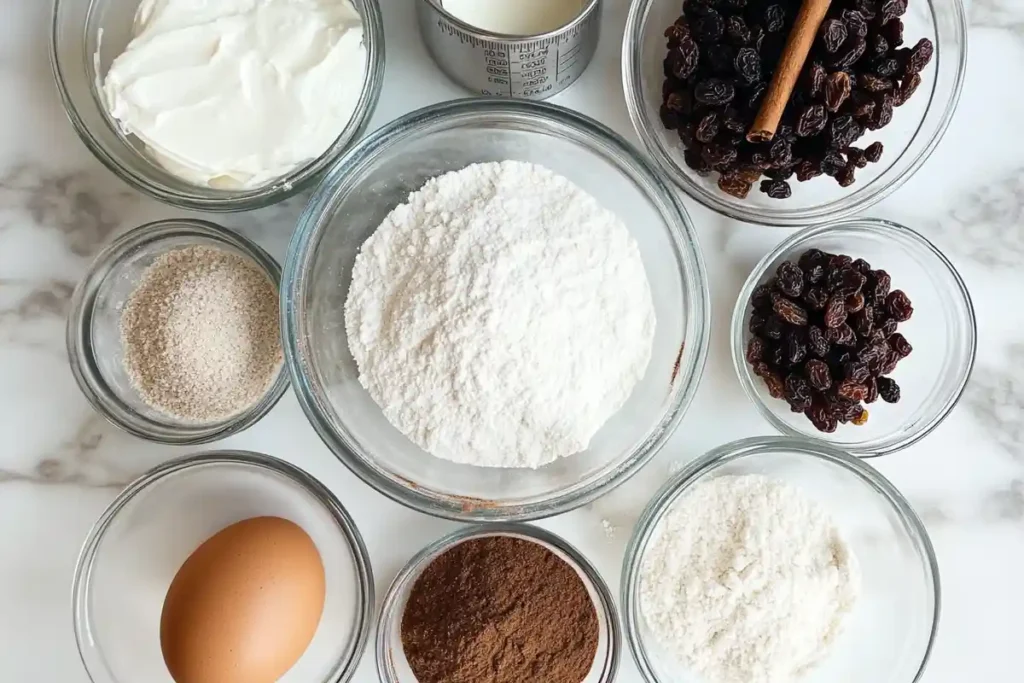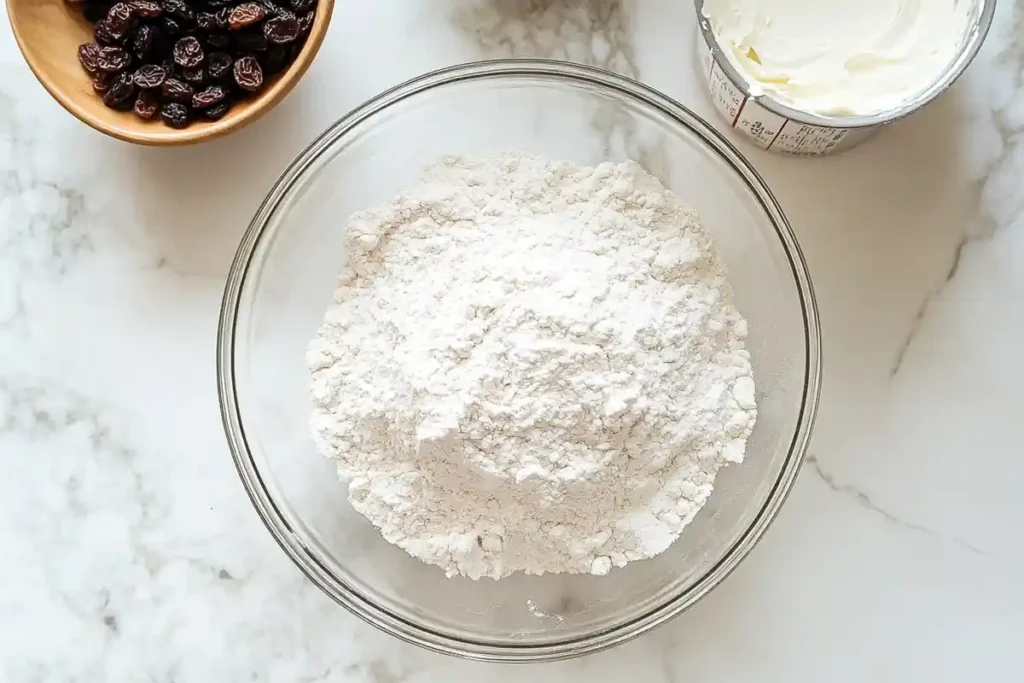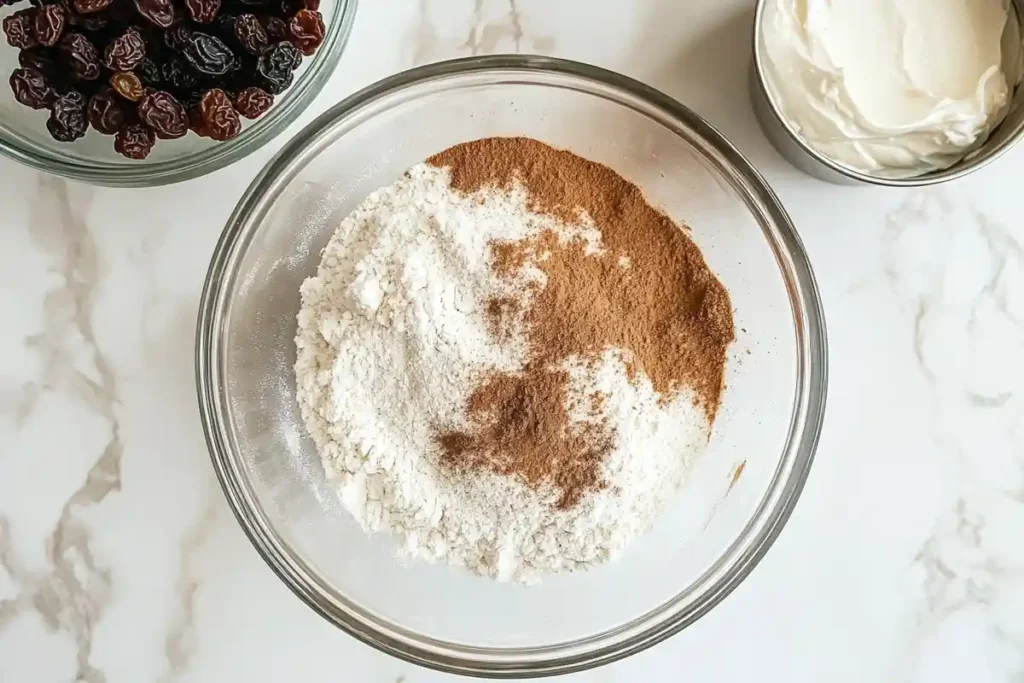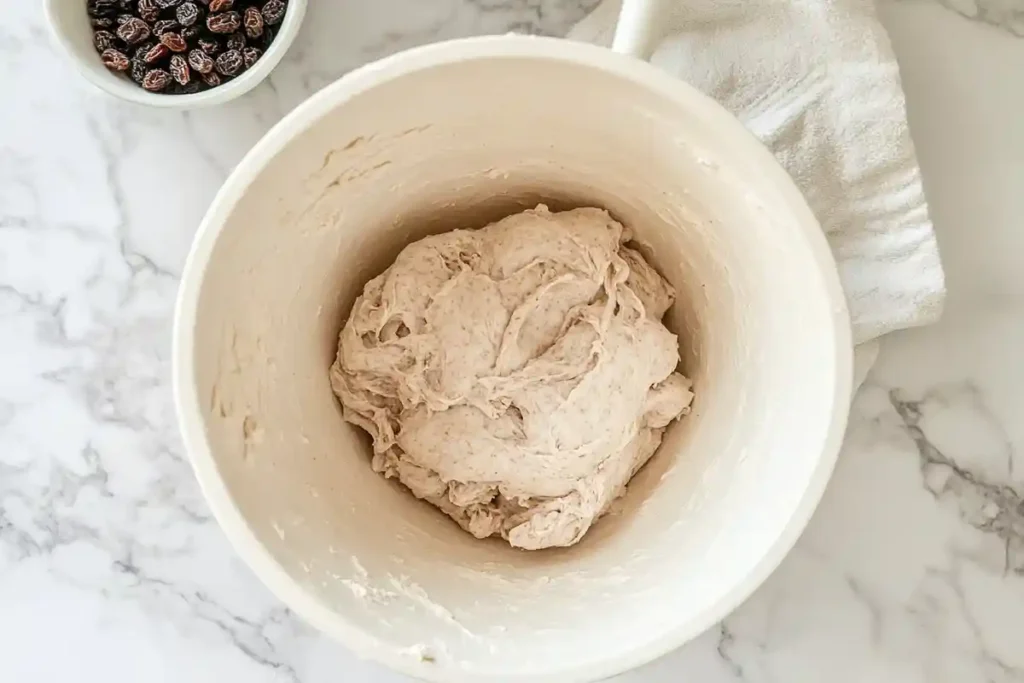Introduction To Sourdough Cinnamon Raisin Bagels
Making homemade sourdough cinnamon raisin bagels is a rewarding culinary adventure. This recipe combines sourdough’s rich, tangy flavor with the warm, spiced sweetness of cinnamon and raisins—resulting in a breakfast or snack option that’s both chewy and utterly delightful. Whether you’re a seasoned sourdough baker or a beginner looking for a fun challenge, these bagels will impress your family and friends. Not only are they a fantastic morning treat, but they’re also freezer-friendly, making it easy to enjoy them on busy days.
This article will guide you through each process step, from preparing the dough to boiling and baking the bagels. Plus, we’ll cover tips for storing and serving them so you can enjoy fresh bagels any time. But Before we dive into the joy of making these sourdough cinnamon raisin bagels, why not explore more sourdough delights? Here are some must-try recipes to inspire your next bake:
- Sourdough Dinner Rolls Recipe – Soft, fluffy rolls perfect for any meal.
- Sourdough Cinnamon Rolls – Sweet, tangy, and perfect for breakfast or dessert.
- Sourdough Bagels – A classic bagel recipe to master the basics.
- Sourdough Sandwich Bread Recipes – Classic sandwich bread with a sourdough twist.
These recipes are sure to add variety to your sourdough journey. Give them a try!
Table of Contents
Inspiration for Sourdough Cinnamon Raisin Bagels
Let’s be honest—cinnamon and raisins are a match made in heaven. They create a warm, comforting, and slightly nostalgic flavor profile. Adding this combo to sourdough bagels elevates an already delicious baked good to something extraordinary. Picture it: the rich aroma of cinnamon wafting through your kitchen as the bagels bake, the chewy texture of the bagel dough, and the juicy pop of raisins in every bite. It’s the ultimate breakfast or snack option, whether you enjoy it plain, toasted, or slathered with your favorite spread.
The love of classic bakery bagels inspired this recipe with a homemade twist. By making them yourself, you can control every aspect—from the quality of the ingredients to the sweetness level. Plus, there’s something magical about crafting a bagel entirely from scratch. And don’t worry, even though it sounds fancy, this recipe is beginner-friendly with easy-to-follow steps.
Why You’ll Love This Recipe

Making sourdough cinnamon raisin bagels at home is easier than you think and so rewarding. Here’s why you’ll fall in love with this recipe:
- Flavor: The tangy sourdough blends perfectly with the sweet raisins and warm cinnamon, creating an irresistibly balanced and comforting flavor.
- Beginner-Friendly: With clear, step-by-step instructions, even sourdough beginners can confidently create bakery-quality bagels.
- Freezer-Friendly: These bagels are stored beautifully in the freezer, making it easy to enjoy a homemade treat on busy mornings or whenever the craving strikes.
You’ll love the chewy texture, the aroma of cinnamon in your kitchen, and the satisfaction of crafting these bagels from scratch!
Ingredients For Sourdough Cinnamon Raisin Bagels
Before making sourdough cinnamon raisin bagels, gathering all your ingredients and tools is important. This preparation will ensure that your baking experience goes smoothly, and the results will be as delicious as you imagine. Let’s break down what you’ll need to create these chewy, flavorful bagels from scratch.
Ingredients Needed

The ingredients in this recipe are straightforward, but each one plays a crucial role in achieving the signature texture and taste of these sourdough cinnamon raisin bagels.
Key Ingredients for the Dough
- Bread Flour
- Bread flour is essential for giving the bagels their classic chewiness. Its higher protein content ensures the dough develops a strong gluten structure, which is key to satisfying texture. If you don’t have bread flour, you can use all-purpose flour, but the results might be slightly less chewy.
- Active Sourdough Starter
- A bubbly, active sourdough starter is the heart of this recipe. It provides the natural fermentation that gives these bagels their tangy flavor and airy interior. If your starter is sluggish, feed it 4-6 hours before starting the recipe to ensure it’s at peak activity.
- Raisins
- Raisins subtly sweetness the bagels, creating a delightful contrast to the tangy sourdough. For the best results, soak the raisins in warm water for 15-20 minutes before adding them to the dough. It keeps them plump and prevents them from drying out during baking.
- Cinnamon
- Cinnamon doesn’t just add flavor—it also infuses the dough with a warm, inviting aroma. However, it’s worth noting that cinnamon can slightly inhibit yeast activity, so we’ll be folding it into the dough later in the process rather than mixing it in upfront.
- Salt
- Salt is a must in any bread recipe. It enhances the flavor and helps strengthen the gluten network. Please don’t skip it!
- Honey or Sugar (Optional)
- Adding a touch of honey or sugar can balance the sourness of the dough and complement the cinnamon and raisins beautifully. It’s optional, but it’s a great way to customize the flavor to your liking.
- Water
- Water is the foundation of the dough. Using room-temperature or slightly warm water ensures the starter activates properly, aiding fermentation.
Supplies Needed
Having the right tools will make sourdough cinnamon raisin bagels much more enjoyable. Here’s what you’ll need:
Essential Baking Tools
- Mixing Bowl
- A large mixing bowl is crucial for combining and proofing the dough. Stainless steel or glass bowls work best since they’re easy to clean and won’t interfere with the dough’s fermentation.
- Kitchen Scale
- Precision is key in baking, and a kitchen scale ensures accurate measurements. Sourdough recipes are particularly sensitive to variations, so weighing your ingredients is highly recommended.
- Parchment Paper and Baking Sheet
- These are non-negotiable for ensuring the bagels don’t stick during their final proof or baking. Parchment paper also makes cleanup a breeze.
- Slotted Spoon
- A slotted spoon is a must for safely removing the bagels from their boiling bath without damaging their shape.
- Bench Scraper
- This tool is incredibly useful for dividing the dough into even portions and shaping the bagels.
- Large Pot
- You’ll need a wide, deep pot for boiling the bagels. This step is crucial for creating the bagels’ signature chewy crust.
- Wire Rack
- A wire rack allows the bagels to cool evenly after baking, preventing the bottoms from getting soggy.
Pro Tips for Preparation
- Soak Your Raisins: As mentioned earlier, soaking raisins in warm water ensures they stay plump and don’t steal moisture from the dough during baking. Drain them well before adding them to the dough.
- Use Fresh Cinnamon: To get the most flavor, use high-quality, fresh cinnamon. Older cinnamon may lose its potency over time.
- Pre-Measuring Ingredients: Weigh and measure your ingredients ahead of time. It saves you from scrambling mid-recipe and helps you stay focused.
Step-by-Step Instructions for Sourdough Cinnamon Raisin Bagels
Now that you’ve gathered all the ingredients and supplies, it’s time to roll up your sleeves and start making your sourdough cinnamon raisin bagels. This step-by-step guide breaks the process into manageable sections, ensuring that even beginners can confidently create chewy, flavorful bagels. Let’s get started!
Make the Dough
The first step to creating delicious bagels is preparing the dough. This part lays the foundation for the chewy texture and tangy flavor we’re aiming for.



- Combine the Ingredients:
- In a large mixing bowl, combine 500g of bread flour, 100g of active sourdough starter, 275g of water, and 10g of salt. Mix it now if you add a sweetener like honey (around 20g). Stir the mixture until it forms a shaggy dough.
- Knead the Dough:
- Transfer the dough to a lightly floured surface and knead it for 5-7 minutes. The dough should become smooth and slightly elastic. If it feels too sticky, add a small amount of flour, but avoid overdoing it. Bagel dough should be firm but pliable.
- Initial Rest:
- Place the dough back into the mixing bowl and cover it with a damp kitchen towel or plastic wrap. Let it rest for 30 minutes, allowing the flour to hydrate fully and the gluten to develop.
Stretch and Fold
Here’s where the raisins and cinnamon come into play. Instead of mixing them into the dough immediately, we’ll gently fold them to avoid damaging its structure.


- Add the Raisins:
- Drain the soaked raisins and gently pat them dry. Spread the dough out slightly on your work surface, sprinkle the raisins evenly over it, and fold the dough in on itself to incorporate them.
- Sprinkle the Cinnamon:
- Dust the surface of the dough with a teaspoon or two of cinnamon. Fold the dough again to distribute the spice evenly. Be gentle to avoid tearing the dough.
- Stretch and Fold Technique:
- Perform three rounds of stretches and folds, spaced 30 minutes apart. To do this, grab one side of the dough, stretch it upward, and fold it over the middle. Rotate the dough 90 degrees and repeat until all sides have been folded. This technique strengthens the gluten structure while evenly distributing the raisins and cinnamon.
Bulk Rise
The bulk rise is a critical step in sourdough baking, allowing the dough to ferment and double in size.
- Cover and Rest:
- Place the dough back in the mixing bowl, cover it with a damp towel, and let it rise at room temperature for 4-6 hours, depending on the ambient temperature. Cooler environments may require longer fermentation times.
- Check for Readiness:
- The dough is ready when it has doubled in size and feels airy and slightly springy when gently pressed. If it hasn’t risen enough, give it more time.
Shape the Bagels
Shaping the bagels is one of the process’s most fun (and hands-on) parts. This step gives the bagels their iconic look.



- Divide the Dough:
- Turn the dough onto a clean surface and divide it into 8 equal portions using a bench scraper. Each piece should weigh roughly 100-110g for evenly sized bagels.
- Shape the Bagels:
- Roll each portion into a ball, then poke your thumb through the center to create a hole. Gently stretch the hole to about 2 inches in diameter, as it will shrink slightly during the second rise and boiling.
Second Rise
The second rise ensures the bagels puff up and develop the right texture before boiling and baking.

- Place on Parchment:
- Arrange the shaped bagels on a parchment-lined baking sheet, leaving space between them to prevent sticking. Cover them with a damp towel.
- Proof Overnight:
- For the best flavor and texture, transfer the shaped bagels to the refrigerator to proof overnight (8-12 hours). This slow fermentation enhances the sourdough flavor and makes the bagels easier to handle during boiling.
If you’re in a hurry, you can proof the bagels at room temperature for 1-2 hours until they appear slightly puffy, but the flavor won’t be as developed.
Boil Bath
Boiling is what gives bagels their signature shiny crust and chewy texture. It also helps the toppings, like raisins, adhere better during baking.

- Prepare the Water Bath:
- Bring a large pot of water to a gentle boil. Add 1-2 tablespoons of honey, sugar, or malt syrup to the water. It enhances the bagels’ flavor and helps them brown beautifully in the oven.
- Boil the Bagels:
- Using a slotted spoon, gently lower 2-3 bagels into the boiling water. Boil them for 30-60 seconds on each side. The longer you boil them, the chewier the texture will be.
- Drain and Transfer:
- Remove the bagels with a slotted spoon and let them drain briefly on a wire rack before transferring them back to the parchment-lined baking sheet.
Bake Sourdough Cinnamon Raisin Bagels
The final step is baking the bagels to golden perfection!
- Preheat the Oven:
- Preheat your oven to 425°F (220°C) while the bagels boil. Place a rack in the center of the oven for even baking.
- Bake the Bagels:
- Bake the boiled bagels for 20-25 minutes until they’re golden brown and sound hollow when tapped on the bottom. Rotate the baking sheet halfway through to ensure even browning.
- Cool on a Wire Rack:
- Once baked, transfer the bagels to a wire rack to cool completely. It prevents the bottoms from becoming soggy.
How to Serve Sourdough Cinnamon Raisin Bagels


Now that your sourdough cinnamon raisin bagels are fresh out of the oven—golden brown, fragrant, and begging to be enjoyed—it’s time to talk about how to serve them for the best flavor experience. Properly storing your bagels ensures you can enjoy them over several days or weeks without compromising their texture and taste.
Bagels are wonderfully versatile, and sourdough cinnamon raisin bagels are no exception. Whether you prefer them toasted or fresh, plain or with toppings, these bagels will quickly become a staple in your kitchen. Here are some delicious serving ideas to inspire you:
Toast for Added Texture
Toasting your bagels is a game-changer, especially if you enjoy a warm, slightly crispy crust paired with a soft interior. Cut the bagel in half, pop it into your toaster, and watch as the cinnamon aroma intensifies while the raisins become even sweeter.
Spread with Butter or Cream Cheese
Nothing beats a slather of butter melting into a freshly toasted bagel. For a creamy and tangy option, opt for plain or flavored cream cheese—cinnamon, honey, or even a raisin-studded cream cheese would pair beautifully with these bagels.
Nut Butters and Fruit Spreads
Spread almond butter, peanut butter, or hazelnut for a protein-packed breakfast or snack. If you have a sweet tooth, try a thin layer of jam or marmalade—apricot, strawberry, or orange complements the bagel’s cinnamon flavor wonderfully.
Breakfast Sandwiches
Why stop at traditional toppings? Transform your bagels into a hearty breakfast sandwich. Add scrambled eggs, a slice of cheese, and crispy bacon for a savory-sweet twist.
French Toast Bagels
Feeling adventurous? Slice your bagels, dip them in a mixture of eggs, milk, cinnamon, and a splash of vanilla, and cook them in a skillet for a unique take on French toast. Drizzle with maple syrup for the ultimate indulgence.
FAQ’s About Sourdough Cinnamon Raisin Bagels
Why boil bagels before baking?
Boiling creates the signature chewy crust by gelatinizing the starch on the surface and locks in the shape. Adding honey or sugar to the boil bath enhances browning and adds a subtle sweetness.
Can I use sourdough discard instead of an active starter?
Yes! Discard works but lacks the strong leavening power of an active starter. Add 1 tsp of commercial yeast to aid rise. The flavor will be milder, and the crumb may be denser.
What are alternatives to honey in the boil bath?
You can use malt syrup, brown sugar, maple syrup, or granulated sugar. Each creates a caramelized crust, so pick based on what you have on hand.
Why add cinnamon later instead of during mixing?
Cinnamon can inhibit yeast fermentation, slowing the rise. Adding it during the stretch-and-fold phase ensures better distribution without affecting the dough’s rise.

